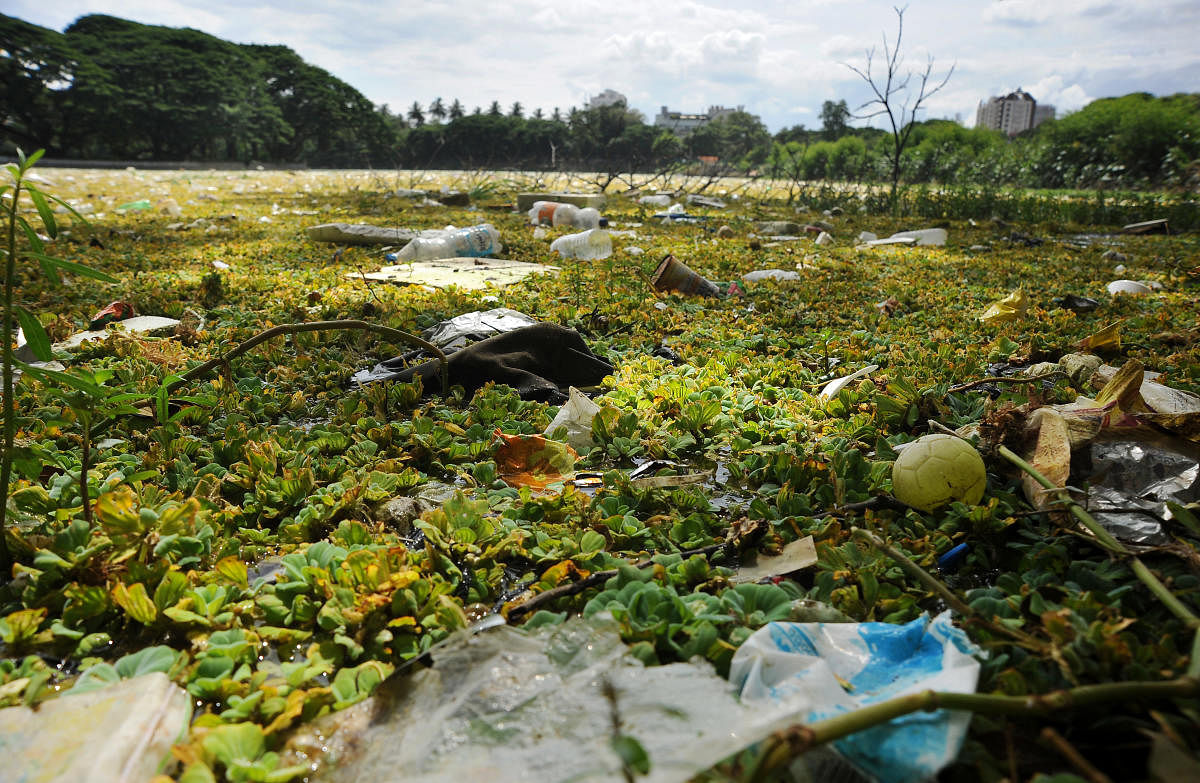
Frothing for years that seemed like eternity, the city’s Bellandur and Varthur lakes had zoomed to notoriety hitting global headlines. But post-lockdown, as a much-delayed de-silting drive is on, a probing query remains disturbingly raw: What stops the original polluters from repeating it once the costly clean-up ends?
Spot visits by a DH team showed the de-silting operation accelerating after the lockdown. Over 15 earth-movers were inside the Varthur lake, scooping out mounds of silt accumulated over decades. Pulled up for inaction by the National Greens Tribunal (NGT), the operation had to pick up pace.
The clean-up drive could take several months to a couple of years. But the visible pace of work has made the polluter query more relevant. Penalised by the Karnataka State Pollution Control Board (KSPCB) for not setting up Sewage Treatment Plants (STPs), several apartment dwellers on the lakes’ periphery want this query to be addressed, and now.
Apartments’ grouse
In a nutshell, their argument is this: During the lockdown, the outflow from apartments had only increased, and yet the lakes appeared dramatically transformed. The water bodies looked cleaner, much less polluted. The apartments wanted the KSPCB to get the message, loud and clear: Industries were always the polluters, and shutting them down stopped the effluent flow.
“The total contribution of the apartments is just one per cent of the sewerage,” contends Bellandur resident and citizen activist Sadasivam Ramakrishnan. “The NGT Experts Committee has also said the apartments are not the root cause. That Bellandur and Varthur lakes turned serene during the lockdown is a glaring evidence of the role played by industries,” he explains.
The KSPCB, Ramakrishnan notes, had always maintained that once the apartments install STPs, the pollution problem would be solved. “It is a hogwash,” he says, reasoning that even before Bellandur became part of the Bruhath Bengaluru Mahanagara Palike (BBMP) in 2007, it was well-served by an award-winning underground drainage network.
Unfairly targeted
The authorities chose not to consider the UGD, and instead ‘targeted’ and ‘victimised’ the apartments in the name of STPs. Even apartments with STPs are being penalised for not treating phosphorus. When BWSSB STPs are not treating for phosphorus, why are apartments being targeted, he asks.
The long-term solution, Ramakrishnan suggests, is to set up community STPs that could be scaled up for additional treatment. Threats of power and water disconnections through alleged ‘data manipulation’ will eventually drive the apartment dwellers to take the legal route.
Diversion canals
But there is another side to the lockdown’s link to pollution. As lake activist Elangovan Kolandaivelu points out, water in the temporary diversion canals around Bellandur would appear cleaner as the soil underneath is fresh unlike the muck inside the lakes. “We cannot conclude whether the pollution reduced during the lockdown,” he notes.
However, he agrees that apartments closer to the lakes bear the brunt of the KSPCB’s legal action. Since Bellandur lake receives an estimated 40% of the sewage generated in the city, polluters along the lakes upstream should be penalised.
Unregulated inflow
Unregulated inflow of industrial effluents into the network of storm water drains leading up to the lakes has often been cited as the prime contributor to pollution. KSPCB is tasked with granting permissions. But its monitoring role is what is of concern. “The Board has to pull up its socks. Where is the real-time monitoring to ensure that the permission conditions are adhere to?” Elangovan wonders.
Also Read: Fix lakes through transparent collaborations
The sewage flow into the two lakes has been diverted through canals. The canals are only temporary and will be removed once the water bodies are rejuvenated. In Varthur, the flow in the canal is thick and fast towards the lakes downstream and the Dakshina Pinakini river further ahead. Upstream, the vast Bellandur lake lies enveloped by weed, hiding the highly polluted water underneath.
Unlike Varthur lake, the earthmovers here are few and far between, operating at a much slower pace. Imposing in its vastness, the city’s largest lake pose a big challenge to the arduous de-silting task. It is clear from the pace of work and lack of urgency that full completion could be delayed far beyond the deadline.
Transporting silt
Transporting the silt could pose another challenge. As Minor Irrigation Minister J C Madhuswamy explained on Thursday, the NGT deadline mandates that about 300 trucks ferry the silt from Bellandur lake daily. Once the process starts, the Minister contends, this would mean operating a truck every minute, triggering big traffic problems.
The task is mammoth, as an estimated 19 lakh million tonnes will have to be ferried 25-40 kms away from the lake. Three quarries in a village in Mylasandra have been identified by the Bangalore Development Authority (BDA) to dump the silt deposits, accumulated over the four decades.
Monsoon complexity
But what next after the lakes are de-weeded and de-silted? That is a question for the future since the slow pace of work faces further disruption from heavy rains. In Varthur lake, earth-movers are now busy carving out a drain to separate the fresh rain water from mixing up with the sewage.
Eventually, the success of the rejuvenation effort will also depend on how fast the work on a new 150-MLD Sewage Treatment Plant (STP) can be completed. Stalled again due to manpower shortage, the plant is now likely to be commissioned only by the year-end or 2021, as a top Bangalore Water Supply and Sewerage Board (BWSSB) official informs. But uncertainty looms.
Vast swathes of Bellandur lake are now covered by weeds. De-weeding has been stalled as the NGT committee felt it would be futile without completion of the de-silting work. Although tenders for the project were invited in February 2020, actual de-silting commenced only on April 24. BDA informs that so far, silt up to a depth of 5ft has been cleared from an area of 100 acres from the two lakes combined.